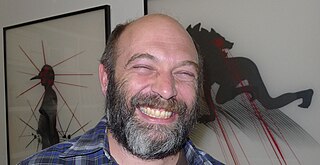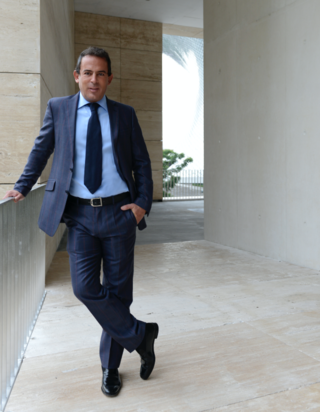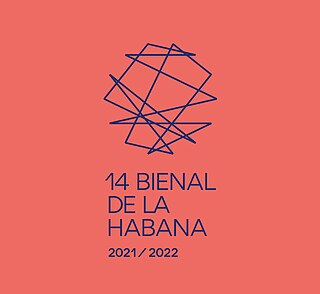
José Luis Cuevas was a Mexican artist, he often worked as a painter, writer, draftsman, engraver, illustrator, and printmaker. Cuevas was one of the first to challenge the then dominant Mexican muralism movement as a prominent member of the Generación de la Ruptura. He was a mostly self-taught artist, whose styles and influences are moored to the darker side of life, often depicting distorted figures and the debasement of humanity. He had remained a controversial figure throughout his career, not only for his often shocking images, but also for his opposition to writers and artists who he feels participate in corruption or create only for money. In 1992, the José Luis Cuevas Museum was opened in the historic center of Mexico City holding most of his work and his personal art collection. His grandson Alexis de Chaunac is a contemporary artist.
Miguel Calderón is a Mexican artist and filmmaker. In the 1990s, along with other artists, he founded the independent art space, La Panadería, in the Condesa neighborhood in Mexico City. Calderón received his BFA at the San Francisco Art Institute in 1994. He has worked in paint, photography, video, film and installation.

Carlos Amorales is a multidisciplinary artist who studied at the Gerrit Rietveld Academy and the Rijksakademie in Amsterdam. The most extensive researches in his work encompass Los Amorales (1996-2001), Liquid Archive (1999–2010), Nuevos Ricos (2004–2009), and a typographic exploration in junction with cinema (2013–present).

Eugenio López Alonso is the sole heir to the Grupo Jumex fruit juice fortune, one of Mexico's most successful national enterprises, the president of Fundación Jumex Arte Contemporáneo, and a significant contemporary art collector.

Iñaki Bonillas is an artist living and working in Mexico City. His recent work is based on the photographic archive of his grandfather J.R. Plaza and family. In 2007 he participated in a group exhibition at Claremont Museum of Art.

Darío Escobar is a Guatemalan artist.
Charles Esche is a museum director, curator and writer. His focus is on art and how it reflects, provokes and influences changes in society. He lives between Edinburgh and Eindhoven.

Abraham Cruzvillegas is a Mexican visual artist. He is best known for his work with found objects, and particularly his ongoing "autoconstrucción" project.
Rubén Torres Llorca is a Cuban artist specializing in painting, drawing, sculpture, collages, and photography. He studied from 1972 to 1976 at the Escuela Nacional de Bellas Artes "San Alejandro" in Havana and from 1976 to 1981, studied at the Instituto Superior de Arte (ISA), also in Havana. Torres resided in Mexico City, Mexico, from 1990 to 1993 and has resided in Miami, Florida, since 1993.

Wilfredo Prieto, is a Cuban conceptual artist.

The Bienal de La Habana was an traditional Latin, Caribbean event, originated in Havana, Cuba, that aims to raise awareness to promote contemporary art and giving priority to Latin-American and Caribbean artists.

Superflex is a Danish artist group founded in 1993 by Jakob Fenger, Rasmus Nielsen and Bjørnstjerne Christiansen. Superflex describe their projects as Tools, as proposals that invite people to participate in and communicate the development of experimental models that alter the economic production conditions. Often the projects are assisted by experts who bring in their special interest, these tools can then be further used and modified by their users.
Mariana Castillo Deball is a Mexican visual artist currently based in Berlin. She works primarily in installation, sculpture, photography and drawing.
Flor Minor is a Mexican sculptor and graphic artist, known for bronze sculptures and graphic work that generally depict the male form. Her works often are based on the concept of balance or lack thereof. Minor has had individual exhibitions in notable venues in Mexico and abroad, and her work can be found in a number of public and private collections. She has been recognized in Mexico with membership in the Salón de la Plástica Mexicana.
David Lamelas is an Argentine artist. A pioneer of Conceptual art, he was involved in Argentina's avant-garde scene in the 1960s. Well known for his sculptures and films, Lamelas lives and works between Los Angeles, Buenos Aires, and Europe.
Lawrence Abu Hamdan is a contemporary artist based in Beirut. His work looks into the political effects of listening, using various kinds of audio to explore its effects on human rights and law. Because of his work with sound, Abu Hamdan has testified as an expert witness in asylum hearings in the United Kingdom.

Luis Felipe Ortega is a Mexican contemporary artist. Since 1993 he has exhibited individually and collectively both in Mexico and abroad. He was a Representative of Mexico's Pavilion in the 56th Venice Biennale in 2015 with Tania Candiani. His dedication on presenting various ideas and visions are honorable as he approached it by means of various mediums such as videos, audio, drawings, sculptures, and installations.
"The journey is very important; if there isn't, you're not in a complex relationship with the part. This journey can go from more to less or from less to more and from there make a series of equations between sculpture, image and sound. All this wants to put the piece itself in crisis."
Adrián Villar Rojas is an Argentinian sculptor known for his elaborate fantastical works which explore notions of the Anthropocene and the end of the world. In his dream like installations he uses aspects of drawing, sculpture, video and music to create immersive situations in which the spectator is confronted with ideas and images of their imminent extinction.
Kurimanzutto is an art gallery located in Mexico City and New York City specializing in contemporary art that represents 33 international artists. It was founded in 1999 by Mónica Manzutto and José Kuri as a gallery without a fixed space. In 2006 it occupied a warehouse in the Colonia Condesa which served as a project space and workshop. In 2008 it opened its main gallery space in Mexico City in the San Miguel Chapultepec neighborhood and in 2018 it opened a project space in New York City.

The H Committee of Human Vindication, better known by its initials HCRH, is a Mexican art collective founded by Rodrigo Azaola, Artemio Narro and Octavio Serra that operated as a phantom and universal pseudo-organization, supposedly founded in 1947. The HCRH created numerous conferences, texts, actions, editorial projects, music, radio programs and artworks that utilize a highly ironic and intellectual language for "ridiculing the hollow pomposity of institutional culture." The public art activities of the HCRH, in festivals for example, were produced between 1996 and 2004, a period in which globalization and neoliberal politics in Mexico were incipient and the market-driven art world was consolidated.











